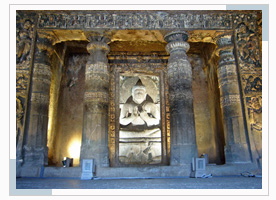Ajanta Caves Maharashtra
AJANTA, located 100 km from Aurangabad district in the state of Maharashtra of India, conjures before one's vision, a dream of beauty- of caves, hidden in the midst of a lonely glen with a streamlet flowing down below, caves that were scooped out  into the heart of the rock so that the pious Buddhist monk, out on mission to spread the tenets of Buddhism could dwell and pray, caves that the followers of Lord Buddha, embellished with architectural details with a skillful command of the hammer over the chisel, with sculpture of highest craftsmanship and above all, with the paintings of infinite charm. The caves including the unfinished ones are thirty in number, of which five (9, 10, 19, 26 and 29) are chaitya-grihas and the rest are sangharamas or viharas (monasteries). After centuries of oblivion, these caves were discovered in AD 1819.They fall into two distinct phases with a break of nearly four centuries between them. All the caves of the earlier phase date between 2nd century BC-AD.
into the heart of the rock so that the pious Buddhist monk, out on mission to spread the tenets of Buddhism could dwell and pray, caves that the followers of Lord Buddha, embellished with architectural details with a skillful command of the hammer over the chisel, with sculpture of highest craftsmanship and above all, with the paintings of infinite charm. The caves including the unfinished ones are thirty in number, of which five (9, 10, 19, 26 and 29) are chaitya-grihas and the rest are sangharamas or viharas (monasteries). After centuries of oblivion, these caves were discovered in AD 1819.They fall into two distinct phases with a break of nearly four centuries between them. All the caves of the earlier phase date between 2nd century BC-AD.
The caves of the second phase were excavated during the supremacy of the Vakatakas and Guptas. According to inscriptions, Varahadeva, the minister of the Vakataka king, Harishena (c. 475-500 AD), dedicated Cave 16 to the Buddhist sangha while Cave 17 was the gift of the prince, a feudatory. An inscription records that- Buddha image in Cave 4 was the gift of some Abhayanandi who hailed from Mathura. A few paintings which survive on the walls of Caves 9 and 10 go back to the 2nd century BC-AD. The second group of the paintings started in about the fifth century AD and continued for the next two centuries as, noticeable in later caves. The themes are intensely religious in tone and centre round Buddha, Bodhisattvas, incidents from the life of Buddha and the Jatakas. The paintings are executed on a ground of mud-plaster in the tempera technique.
THE TOUCH OF BUDDHISM
At Ajanta, the paintings on the walls, illustrate the events in the life of prince Gautama Buddha, the founder of Buddhism and in the more popular Jataka stories pertaining to Buddha's previous incarnation. According to the older conceptions, the Buddha wrought many deeds of kindness and mercy in a long series of transmigration as a Bodhisattava, before achieving his final birth as the sage of sakyas. Incidentally they contain the scenes of semi-mythological history, the royal court and popular life of the ancient times, as told in romances and plays. Some pictures recall the Greek and Roman compositions and proportions, few late resemble to Chinese manners to some extent. But majority belongs to a phase which is purely Indian as they are found no where else. These monuments were constructed during two different periods of time separated by a long interval of four centuries. The older ones were the product of last to centuries before Christ and belongs to Hinayana period of Buddhism in later part of 2nd century AD when Buddhism was divided into two sections, after the conduct of the fourth general council under another great king, Kanishka.
The new feature of Mahayana Buddhism was the concept of future Buddha's. The Buddha, himself probably thought that he was the last of the long succession of earlier Buddha's who lived before him. According to the Buddhist traditions, these former Buddhas were revered even in the historical Buddha's lifetime.
By the time king Ashoka, their cult was widespread and was patronized by Ashoka. Later, when the stupas were constructed and beautified, the carvings were executed in a symbolic way. An inspired sculptor began to carve images of Buddha himself and within the few generations, all the Buddhist sects took to worshipping images.
The universe of Mahayana contains numerous Bodhisattava, the chief of whom is Avalokitesvara with attributes of compassion. He is also called Padmapani or the lotus bearer. The Manjushri with a naked sword in one hand, stimulates the understanding. The sterner Bodhisattava who is a foe of the sin and evil and bearing a thunderbolt in the hand is Vajrapani. The future Buddha, Maitreya will take birth to save the world.





